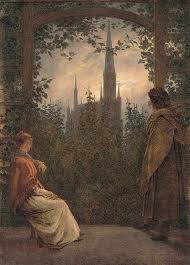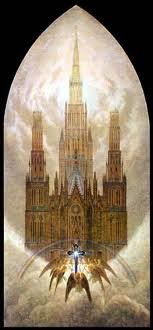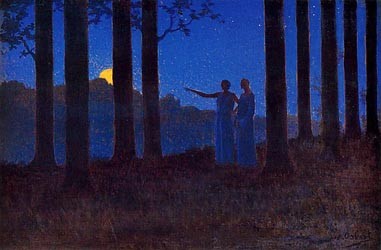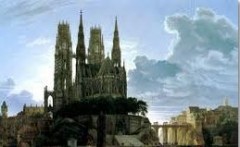![1015704_roh_v1[1].jpg](http://theblogofdreams.blogspirit.com/media/01/00/1833233163.jpg)
Last time we saw how Sylvia is intrigued by her dreams. They know everything of her life, the past, the future and they protect her night after night against the dangers of the life.
So she finally asks her dreams : What are dreams ? Here is the dream she got :
Dream
Driving my car, I arrive in front of a church. Mathilda is there waiting for me out front below the stairs. I step out of the car, she comes towards me with an outreaching hand and having got hold of mine, she takes me into the church.
Interpretation
Driving my car, I arrive
Sylvia has a car, which indicates that she has a fast and comfortable way of going forward in life.
We should note that a car rides on roads built for this purpose, that indicates that the dreamer easily goes forward in life on pre-established pathways same as everyone else. She is not part of those who advance slowly on foot, searching for their own way, surmounting the obstacles of the individual path.
![Carus_-Carl-Gustav.-Pilger-im-Felsental.-um-1820[1].jpg](http://theblogofdreams.blogspirit.com/media/01/00/2221901794.jpg)
I arrive in front of a church
This young woman is not particularly interested in spirituality. She has vaguely heard about Christ, the crucifixion, mass, communion and the Holy Spirit. For her the church is a building that was erected to greet the divine, to allow everyone to listen within where one can meet Him .
But in her everyday life Sylvia doesn’t go to church, so the church of her dream does not speak about the external church, but about an interior place.
So what does this mean in regards to the question asked : what are dreams?
Dreams are her interior church where she can meet the divinity and commune with It.
That’s all ! …
She got an immediate, clear, simple and direct answer.
But for the time, Sylvia has not yet entered this sacred place. She just arrives in front of this opportunity.

Mathilda is waiting for me below the stairs
Mathilda is her dream interpreter. She is aware of this dimension and is waiting for the dreamer to let her discover the interior reality.
I get out of my car
However, before being introduced, initiated, Sylvia must get out of her car, give up her habit of following pre-established ways to go forward.
How that ? She must set her two feet BELOW, DOWN on the ground, be more humble, walk by her own means to meet the dream interpreter.
Only with this humility she will be able to go UPstairs into the sacred place.
Mathilda comes towards me with an outreaching hand
Here the dream insists, it presents to the dreamer the interpreter who offers her help and support. It emphasizes that it is with her, thanks to her that Sylvia will be able to enter the dream path.
![2961390517_1_3_qqfo3QSS[1].jpg](http://theblogofdreams.blogspirit.com/media/00/01/1705737867.jpg)
Having got hold of my hand she takes me into the church.
Mathilda, the interpreter then brings the young woman into her inner church, into her dreamworld within which the divine resides.

Conclusion
So, Sylvia had asked the incubation question : What are dreams?
Her dream answered:
Dreams are the interior church where the sacred encounter between human and divine unfolds. That’s why dreams are all-knowing, that’s why they are so wise and clairvoyant.
Comment
Surprising? Perhaps.
Really?
Not really, for what have all the old societies preceding us on earth said ? Didn’t they all declare that the dream is the natural channel through which the human soul meets the divine?
Everywhere one finds the widespread affirmation that dreams give access to another level of consciousness, which surpasses the conscious and grants knowledge that it would not have access to on its own.
Scientifically today we call this other level of consciousness the unconscious.
It is a question of vocabulary of course but we must know how others understand that word. Cultures who differ from ours consider that the unconscious, this other level of consciousness to which dreams give access to, is that of divine forces. That’s how they name it.
In preceding texts I have shown you that in Antiquity, for all, whether they be Egyptians, Greeks, Romans, Jews, or Africans the divine spoke through dreams, whether he was called Yahweh, God or Aesculapius, Jupiter… And I didn’t speak yet of the Indians of the Americas and of others throughout the world. For them the unconscious is the expression of the divine dimension.
Sylvia’s dream says the same thing: the dream is the moment of encounter with an interior force, which proves a wisdom beyond our understanding.

What can the rational say? Could scientific reason be brought to recognize that as far as dreams are concerned it finds itself faced with a dimension with its own laws the rational does not know about, and which extends beyond its competency?
Could reason accept that rational means have attained their limits regarding the unconscious? Then, logically and rigorously reason would declare that it can’t say anything except that it finds itself facing a hyper-rational dimension.
That would be honest !
![osbert4[1].jpg](http://theblogofdreams.blogspirit.com/media/00/00/1617000845.jpg)
Illustrations
I thank the artists for their illustrations listed in order of their presentation :
Evening at Antiquity, 1908, by the French painter Alphonse Osbert, 1857-1939.
Pilgrim in a Rocky Valley, 1820, by the German artist Carl Gustav Carus
The Cathedral, by the German artist Caspar David Friedrich (1774-1840)
The Cathedral, by the German artist Friedrich Schinkel (1781-1841)
Hand in hand : liloo.citations.skyrock.com
Mystery of the Nignt, by Alphone Osbert
Moonlight, 1896, by the French artist Alphonse Osbert, 1857-1939
